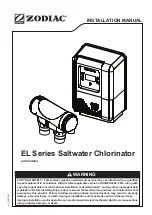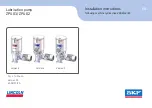
7
VI RECOMMENDED DISINFECTING PROCEDURE
(AFTER INSTALLATION IS COMPLETE)
The storage tank lines going to the faucet must be disinfected to prevent bacteria contamination and
possible odor problems from developing. A dirty prefilter cartridge can also cause odors to develop.
Trace amounts of hydrogen sulfide or methane gas dissolved in the raw water can also cause problems.
(These gaseous compounds will permeate into and through the RO membranes).
The method for proper disinfecting is by using household chlorine bleach and the P6UC4 tube fitting
supplied with the RO unit in the accessory kit: (Refer to Drawing.)
1. Unplug the RO unit. The power must be off before disinfecting.
2. Turn the water supply off (cold water valve).
3. Drain the storage tank.
4. Disconnect the tube from the feedwater fitting going to the pump (step 1).
5. Disconnect the 1/4” tube on the check valve pressure tee switch from the unit (step 2).
6. Remove the 3/8” and 1/4” nuts, grab rings, spacers, and O-rings from the P6UC4 poly fitting.
Put them aside and keep them as spares.
7. Connect the P6UC4 Poly fitting to the ends of the each of the tubing connections removed
(step 3). The tubing connections are long enough to bend together but be careful not to kink
any tubing connections. Connecting these tubes will by-pass the pump during the disinfecting
procedure.
7. Remove both of the carbon cartridges from the housings on the CAK-139 BP or the sediment
filter from the housing on the NAK-139 BP. Add 1 ounce of household chlorine bleach to the
filter sump and place back on the unit. Open the feedwater supply (cold water valve) and the
RO faucet on the sink. Run the water until a strong chlorine bleach smell is noted.
8. Close the RO faucet and fill the pressure tank. Let the tank sit for 30 minutes, allowing the
chlorine to kill any bacteria that might be present. Drain the tank and close the cold-water
valve.
9. Disconnect the P6UC4 Poly fitting and reconnect the tubing to their original connections.
10. Plug in the RO unit.
11. Open the cold-water valve and let the RO water to fill the pressure tank. Drain and flush the
tank several times to remove the chlorine. DO NOT USE THE FIRST 2 TANK-FULLS OF
WATER!!
Summary of Contents for CAK Series
Page 12: ...12...































